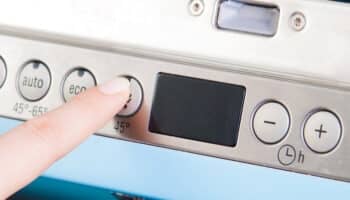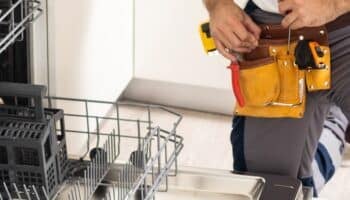We've independently reviewed this article to make sure it's as accurate as we can make it.
To find out more about our article creation and review process, check out our editorial guidelines.
Stuck trying to figure out the cause behind your dishwasher overflow problems?
I know how annoying it can be when your dishwasher stops working. Luckily, you’ve come to the right place!
If your dishwasher is overflowing with water, you’ll need to reduce the soap, inspect the door gaskets, and check the hose for a leak. Replacing the water inlet valve and fixing the float assembly can also do the trick.
Ready to solve the problem? Let’s dive in!
Why trust us? This article was written by Craig Anderson and James Blackford.
Craig has helped thousands of other homeowners repair their appliances since 2016. James is one of our resident appliance experts, with over 16 years of experience. He currently works as a Master Technician for SquareTrade, and runs his own appliance repair business.
Fixing a Dishwasher Overflowing With Water: 8 Simple Steps
Fixing a dishwasher that keeps overflowing is simpler than you think! You’ll just need to follow these eight quick steps:
#1 Reduce the Soap
In my experience, using less soap is one of the easiest ways to fix a dishwasher that keeps overflowing with water.
Your dishwasher can overflow if you fill it with more detergent than it can cope with. The soap suds expand and overflow the door gaskets, spilling onto the floor.
Using a low-quality detergent can also cause your dishwasher to overflow, as cheaper soap tends to create excessive suds.
I recommend filling your dishwasher with less detergent and changing your current soap for one that doesn’t create excessive suds.

When purchasing a new detergent, please consider your water hardness and needs. Don’t forget to read customer reviews to get an idea of its performance and quality.
#2 Check Your Dishwasher’s Position
Having your appliance leaning forward is also one of the most common causes of dishwasher overflow, making water gather at the front and seep through.
You can compare the size of the unit with the surrounding cabinet to determine if it’s tilting in any direction. Make sure your dishwasher isn’t inclined forward.
Your dishwasher should be slightly tilted backward rather than forward.
#3 Inspect the Door Gaskets
If your dishwasher keeps overflowing with water, then there’s a good chance the door gaskets are loose, dirty, or worn out.
You see, damaged seals won’t be able to keep water inside your dishwasher.
So what can you do? Here are two tips:
- Replace the door gaskets if they are cracked, torn, or show signs of wear and tear. New gaskets usually cost around $10 to $20, and installing them is very simple. You’ll just need to unscrew the old gaskets and slide them off your dishwasher. Then screw the new ones on. Please note that the process of replacing the gaskets will vary depending on the specific model you own.
- If the door gaskets are dirty, clean them. Use warm soapy water and a cleaning cloth that is slim enough to get through the grooves of the gaskets.
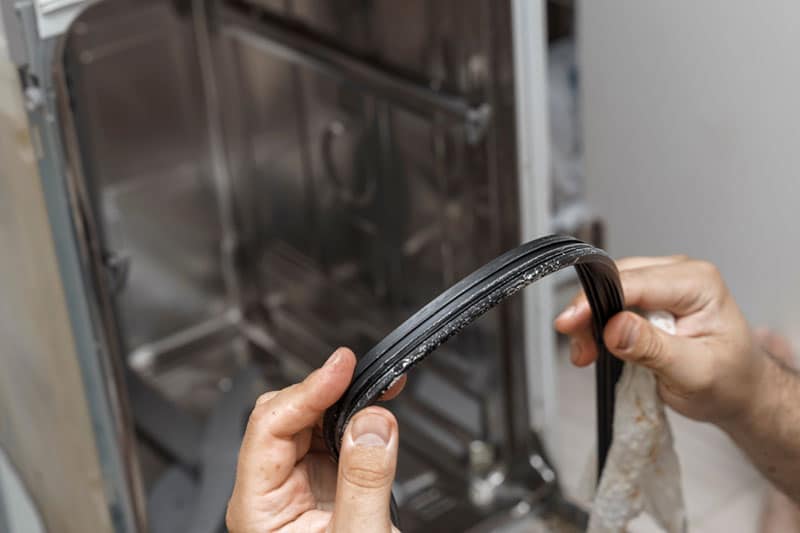
If you want to get any replacement part – or see how much one would cost – click to enter your model number in the search bar below. Our partners at AppliancePartsPros stock almost every part with free guides on how to install them.

#4 Unclog the Bottom
To troubleshoot your dishwasher overflow, you’ll also need to clean the bottom and filter.
In the past, presoaking or even prewashing some of your pots and pans was essential to clean them during a cycle. Nowadays, you can put your cutlery into a dishwasher without even scraping it.
But all of the unscraped food from our plates has to go somewhere. Food debris is likely the reason why your dishwasher is overflowing.
I recommend checking the bottom of your dishwasher for food scraps too big to pass through the waste pipe. These could be blocking your dishwasher from draining its water and thus flooding the kitchen.
Clear the bottom of your dishwasher after each use to keep it from overflowing. It’s also important to keep your filter clean.
I recommend cleaning your filter with hot soapy water and a wire or stiff nylon brush at least once a month. Click here to learn other maintenance tips that will help you prevent water leaks and get the most out of your dishwasher.
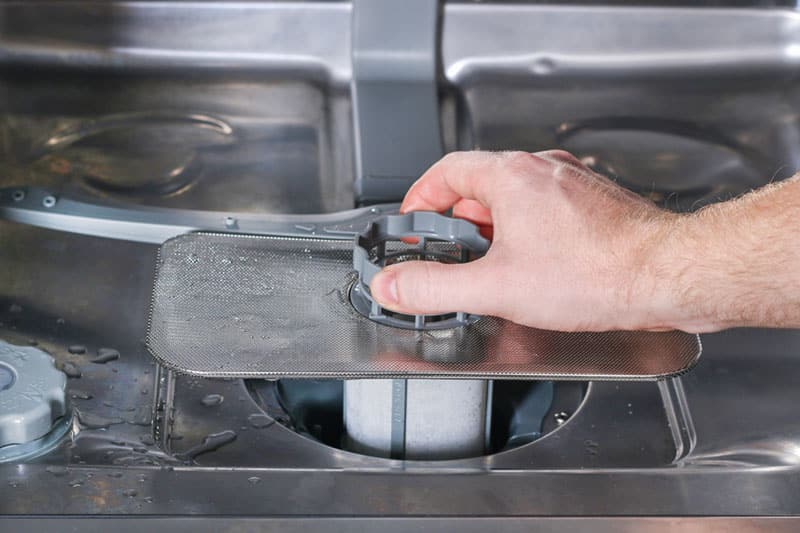
#5 Fix the Float Assembly
In my experience, many dishwasher overflowing problems are linked to the float assembly. This component regulates the amount of water in your dishwasher.
As water enters your dishwasher, it causes the float to move upward, signaling the water valve to shut off, thereby preventing any overflows.
If the float gets stuck, the water valve will not know when to turn the water off, causing your dishwasher to keep filling up with water.
So, what can you do if you suspect your dishwasher is overflowing due to a faulty float assembly? I recommend following these steps:
- Locate the float switch. You can look at this quick tutorial video that will help you find it.
- Check and see if the float switch moves freely up and down. If it is stuck, you will have to clean it with a brush to remove any dirt or debris from the inside and outside of it. This is especially important if you live in a hard water area.
- Reinstall the float.
#6 Check the Hose For a Leak
Your dishwasher can also overflow with water if there is a leak in the drain hose or water supply hose.
In my experience, if there is a leak in either of these places, the water will struggle to get to your sink drain or garbage disposal. This is why the water ends up backing up and overflowing your dishwasher.
To solve the issue, I recommend following these instructions:
- If the drain hose is leaking, tighten the hose clamp screws. You can tighten the nuts and replace the thread seal tape for an extra water-tight fit.
- If the drain hoses still leak after tightening, they need replacing. These are model-specific parts, so you can’t just buy one from a hardware store – you’ll need to order one online (or get help from a pro).
I recommend checking your dishwasher’s manual. If you can’t find yours, don’t worry – we’ve got you covered! Read our detailed guide on how to find any product manual online:
#7 Replace the Water Inlet Valve
Your dishwasher can also overflow due to a leaking water inlet valve.
The valve supplies your dishwasher with water. If it is cracked, more water will flood into the dishwasher than it can handle, resulting in flooding.
But this isn’t only a problem while your dishwasher is in operation. A cracked water inlet valve could cause your dishwasher to flood with water even when it is off.
So if your dishwasher is out of action but still floods, there’s a good chance the inlet valve is the culprit.
To solve the issue, please inspect the water inlet valve, and if you find a crack or tear, please replace it.
Make sure to read the manufacturer’s manual for detailed instructions. If you don’t feel comfortable replacing the water inlet valve yourself, please call a professional.
#8 Replace a Broken Spray Arm
If you’ve tried all the fixes above, but your dishwasher continues to overflow, then it’s time for us to check the spray arms.
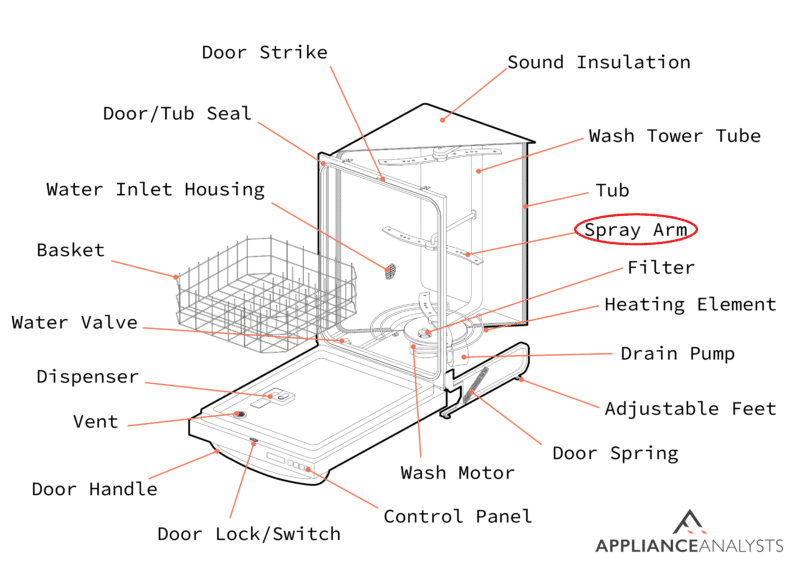
The spray arms in your dishwasher help coat your dishes with water and detergent. Water is forced through them by the pump and motor, and the force of the water cleans the dishes.
Water can go everywhere if the spray arms in your dishwasher have split or are damaged.
For example, if the lower spray arm is cracked, it can expel water straight out instead of directing water upwards through the spray holes. This can cause the water to hit your dishwasher door, overflowing and leaking.
Your dishwasher’s spray arms must work properly. If they do not, you will have to remove the spray arms and replace them with new ones.
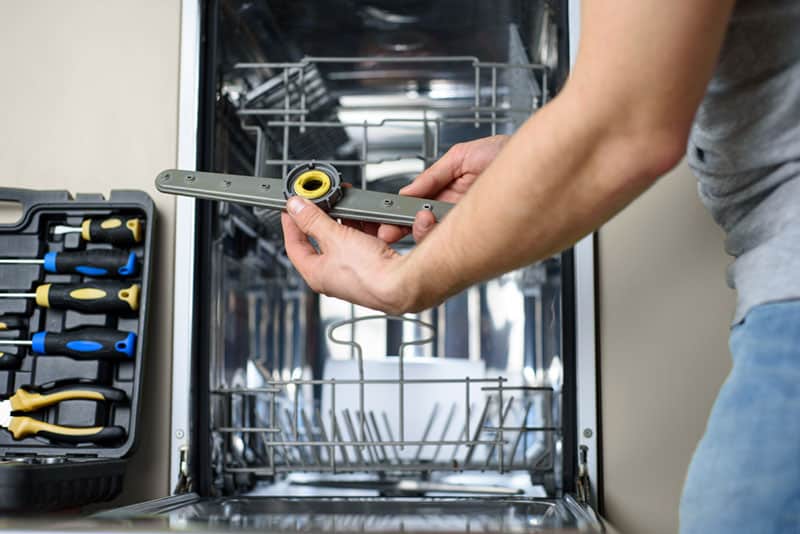
If you want to get any replacement part – or see how much one would cost – click to enter your model number in the search bar below. Our partners at AppliancePartsPros stock almost every part with free guides on how to install them.

Conclusion
I hope this article helped you solve the issue causing your dishwasher to overflow with water.
Remember, if your dishwasher keeps overflowing, you’ll need to use less detergent and ensure it’s not leaning forward. It’s also important to clean the bottom of your dishwasher and its filter.
Don’t forget to check the float assembly, water inlet valve, and spray arms to stop your dishwasher from overflowing.
Thank you so much for reading this article! If you found it helpful, please check out our other related posts below.
Have a great day!
-Craig







